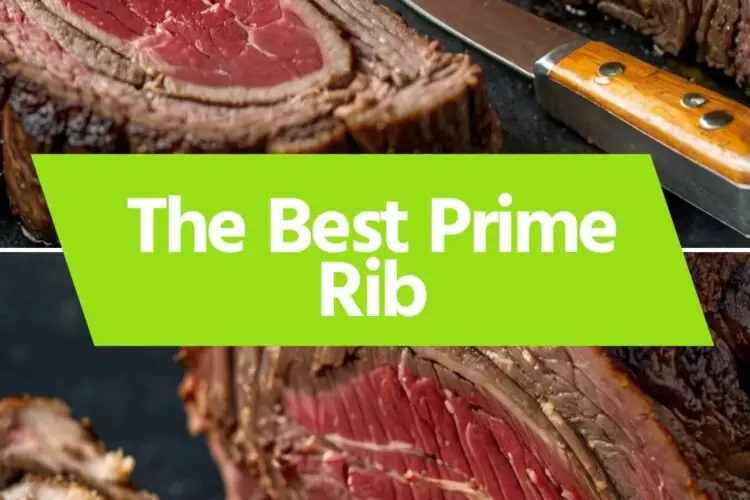As a food enthusiast, my journey with prime rib has been nothing short of exciting. I remember the first time I tasted a perfect prime rib. It was at my uncle’s holiday feast. The meat was tender, juicy, and seasoned just right. I believe that the side dishes played a crucial role in that memorable meal.
This dish pairs well with buttery mashed potatoes and a fresh green salad, both providing a nice contrast to the richness of the rib. Imagine smooth, creamy potatoes melting away in your mouth with each bite of perfectly cooked meat.
How about we dive into what makes a prime rib the best?
What is the Best Prime Rib?
In simple terms, prime rib is a cut from the primal rib section of the beef. This section contains some of the most tender and flavorful cuts of meat available. A prime rib roast includes the ribeye and is often served with a bone—which adds more flavor during cooking. Enjoying prime rib means savoring both its taste and texture.
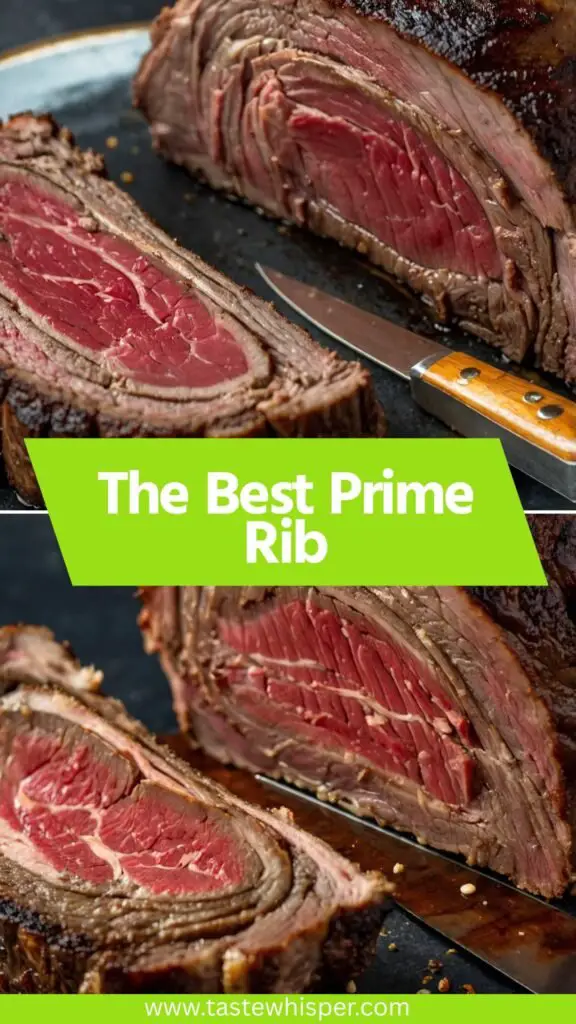
You Might Also Like These Recipes!
The Ingredients
Here’s what you need to create your prime rib masterpiece. Gather these ingredients:
- 6 pounds bone-in prime rib (bones removed and tied back on)
- 1 teaspoon Dijon mustard
- ½ cup unsalted butter, softened
- 6 garlic cloves, finely minced
- 1 tablespoon coarse kosher salt
- 1 teaspoon freshly ground black pepper
- 1 teaspoon fresh rosemary, finely chopped
- 1 teaspoon fresh thyme leaves, chopped
- 1 small shallot, quartered (optional, for red wine au jus)
Red Wine Au Jus (Optional)
- 2 cups beef stock
- 1 ½ cups dry red wine
- ¼ cup pan drippings from the prime rib, fat separated
- Optional: 1 tablespoon arrowroot powder or cornstarch slurry (to thicken)
How to Make the Best Prime Rib
Before digging into the step-by-step directions, remember that cooking this dish is as much about the technique as it is about the ingredients. Proper seasoning, attention to cooking time, and resting periods contribute significantly to the final product.
Step-by-Step Directions
Step 1: Preparing the Prime Rib
Start by preheating your oven to 500 degrees Fahrenheit. While this heats, take the prime rib out of the refrigerator to ensure it comes up to room temperature. This step is crucial as it helps with even cooking. Pat the surface of the meat dry with paper towels.
Step 2: Seasoning
Mix the softened butter, minced garlic, Dijon mustard, coarse salt, black pepper, rosemary, and thyme in a bowl. Apply this compound butter generously over the entire surface of the prime rib. Make sure to work it into any nooks and crannies. You want flavor, and this is where it starts.
Step 3: Roasting the Prime Rib
Place the seasoned prime rib in a roasting pan, bone side down. Put it into your preheated oven for 20 minutes at 500 degrees. This initial high temperature will create a beautiful crust. After 20 minutes, reduce the oven temperature to 325 degrees and continue cooking. As a rule of thumb, roast for about 15-20 minutes per pound for medium-rare. Use a meat thermometer to check for doneness. Aim for 130 degrees Fahrenheit for medium-rare.
Step 4: Resting the Meat
Once the prime rib reaches your desired temperature, take it out of the oven. Let it rest for at least 20-30 minutes. This step is vital for juicy meat as it allows the juices to redistribute.
Step 5: Making the Au Jus
While the prime rib rests, make your au jus. Gather your beef stock, dry red wine, and pan drippings. In a saucepan, combine these ingredients and bring them to a simmer. If you like a thicker consistency, whisk in a slurry made of arrowroot powder or cornstarch dissolved in a splash of cold water. Keep it on low heat until ready to serve.
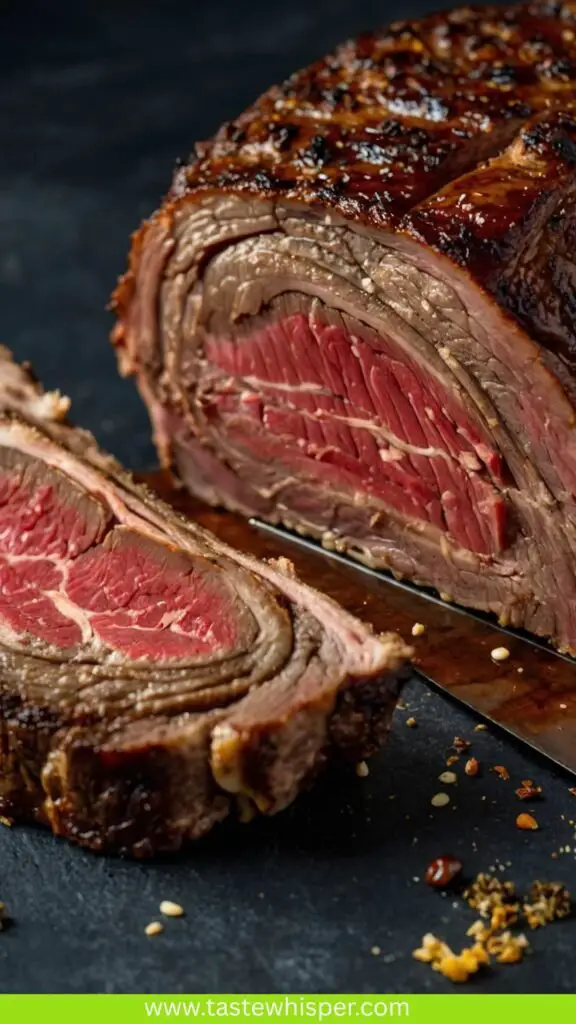
Notes
Here are some helpful tips to ensure success with your prime rib:
Choosing the Right Cut: Select a prime rib with good marbling. Higher fat content means better flavor.
Season Generously: Seasoning is key. Don’t hold back on the salt and herbs!
Invest in a Meat Thermometer: This tool ensures you don’t overcook or undercook. Ideally, go for an instant-read one.
Resting is Non-Negotiable: Resist slicing in too soon! Patience is rewarded with juicy cuts.
Practice Your Carving Skills: A sharp knife makes all the difference. Practice carving against the grain.
Storage Tips
If you find yourself with leftovers, don’t worry! Store your prime rib in an airtight container in the refrigerator and consume within 3-4 days. Feel free to freeze portions for later enjoyment. When reheating, do so gently to maintain tenderness.
Nutrition Information
On average, a 3-ounce serving of prime rib contains approximately:
- Calories: 290
- Protein: 25g
- Fat: 21g
- Carbohydrates: 0g
Nutrition values can vary depending on preparation and cooking methods.
Serving Suggestions
Here are some enjoyable ways to serve your prime rib:
1. Classic Mashed Potatoes: Creamy mashed potatoes pair beautifully with the rich flavor of prime rib. A little bit of garlic mixed in elevates the dish.
2. Fresh Green Salad: A crisp salad with vinaigrette can cut through the richness of the rib. Use mixed greens with sliced avocado and cherry tomatoes.
3. Roasted Vegetables: Carrots, Brussels sprouts, and potatoes add color and texture. Toss them in olive oil and a sprinkle of salt before roasting.
4. Yorkshire Pudding: These puffy pastries can soak up the juices from the rib. They are often considered a must-have pairing.
5. Red Wine Sauce: The au jus is a star itself. Drizzle it over each slice for added depth of flavor.
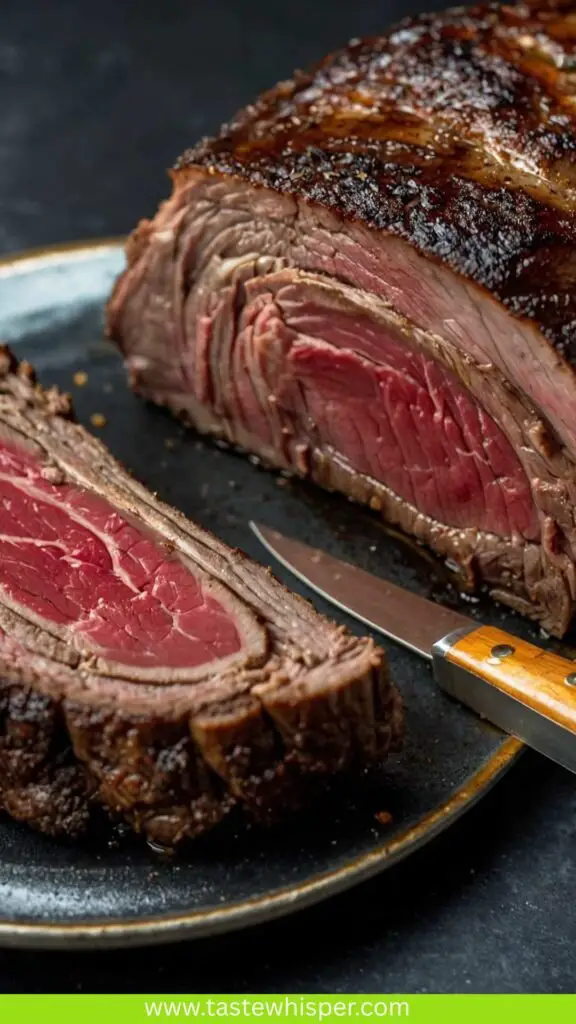
What Other Substitutes Can I Use in Best Prime Rib?
If prime rib isn’t available, don’t feel left out. There are great substitutes!
Ribeye Roast: Almost identical in flavor, a ribeye roast can provide the same tender experience with slightly less fat.
Tenderloin Roast: If you prefer a leaner cut, tenderloin offers tenderness but less flavor compared to prime rib.
Chuck Roast: For a more economical choice, chuck roast can work. Slow cooking renders it juicy and flavorful, though it won’t have the same tenderness.
Brisket: This cut can be used, especially if you are looking for an alternative for smoking. It has a rich flavor but requires a different cooking approach.
Pork Rib Roast: If you’re open to pork, this roast can provide a unique twist while still being flavorful.
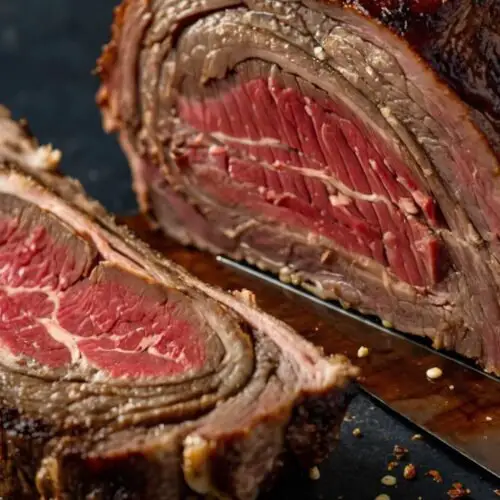
The Best Prime Rib
Equipment
- pan
- Oven
Ingredients
- Here’s what you need to create your prime rib masterpiece. Gather these ingredients:
- 6 pounds bone-in prime rib bones removed and tied back on
- 1 teaspoon Dijon mustard
- ½ cup unsalted butter softened
- 6 garlic cloves finely minced
- 1 tablespoon coarse kosher salt
- 1 teaspoon freshly ground black pepper
- 1 teaspoon fresh rosemary finely chopped
- 1 teaspoon fresh thyme leaves chopped
- 1 small shallot quartered (optional, for red wine au jus)
Red Wine Au Jus (Optional)
- 2 cups beef stock
- 1 ½ cups dry red wine
- ¼ cup pan drippings from the prime rib fat separated
- Optional: 1 tablespoon arrowroot powder or cornstarch slurry to thicken
Instructions
- Before digging into the step-by-step directions, remember that cooking this dish is as much about the technique as it is about the ingredients. Proper seasoning, attention to cooking time, and resting periods contribute significantly to the final product.
- Step-by-Step Directions
Step 1: Preparing the Prime Rib
- Start by preheating your oven to 500 degrees Fahrenheit. While this heats, take the prime rib out of the refrigerator to ensure it comes up to room temperature. This step is crucial as it helps with even cooking. Pat the surface of the meat dry with paper towels.
Step 2: Seasoning
- Mix the softened butter, minced garlic, Dijon mustard, coarse salt, black pepper, rosemary, and thyme in a bowl. Apply this compound butter generously over the entire surface of the prime rib. Make sure to work it into any nooks and crannies. You want flavor, and this is where it starts.
Step 3: Roasting the Prime Rib
- Place the seasoned prime rib in a roasting pan, bone side down. Put it into your preheated oven for 20 minutes at 500 degrees. This initial high temperature will create a beautiful crust. After 20 minutes, reduce the oven temperature to 325 degrees and continue cooking. As a rule of thumb, roast for about 15-20 minutes per pound for medium-rare. Use a meat thermometer to check for doneness. Aim for 130 degrees Fahrenheit for medium-rare.
Step 4: Resting the Meat
- Once the prime rib reaches your desired temperature, take it out of the oven. Let it rest for at least 20-30 minutes. This step is vital for juicy meat as it allows the juices to redistribute.
Step 5: Making the Au Jus
- While the prime rib rests, make your au jus. Gather your beef stock, dry red wine, and pan drippings. In a saucepan, combine these ingredients and bring them to a simmer. If you like a thicker consistency, whisk in a slurry made of arrowroot powder or cornstarch dissolved in a splash of cold water. Keep it on low heat until ready to serve.
Notes
Nutrition
Frequently Asked Questions
How do I know when my prime rib is done?
Using a meat thermometer is the best way to check. For medium-rare, aim for 130–135 degrees; for medium, go for 140–145 degrees.
Can I cook the prime rib in a slow cooker?
While you can cook it in a slow cooker, it won’t develop the same crust. For flavor, sear it first on the stovetop before slow cooking.
What kind of red wine should I use in the au jus?
Select a dry red wine, such as Cabernet Sauvignon or Merlot. They contribute ample depth and flavor to your sauce.
How do I carve the prime rib?
Start by cutting the string and gently removing the bone if you have it attached. Then use a sharp knife to slice along the grain for consistent pieces.
Can I make prime rib ahead of time?
It’s best when served fresh. However, you can prepare the seasoning and au jus ahead. Reheat the meat gently if you must enjoy it later.
Conclusion
There you have it—a complete guide to crafting the best prime rib. Each step, from selecting quality ingredients to proper resting and serving, is essential. I hope this culinary adventure inspires you to create a meal that will become a cherished memory at your next gathering. Happy cooking!

